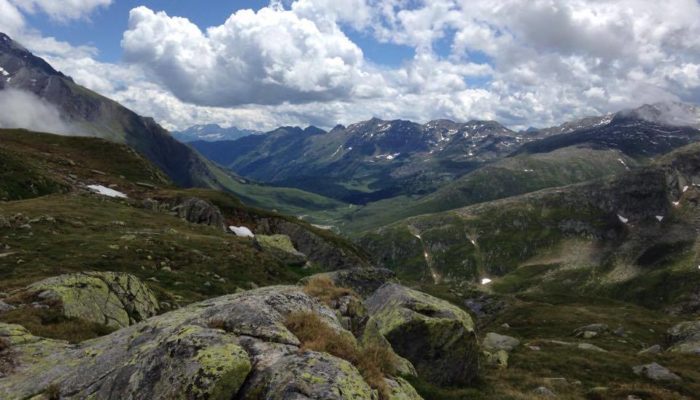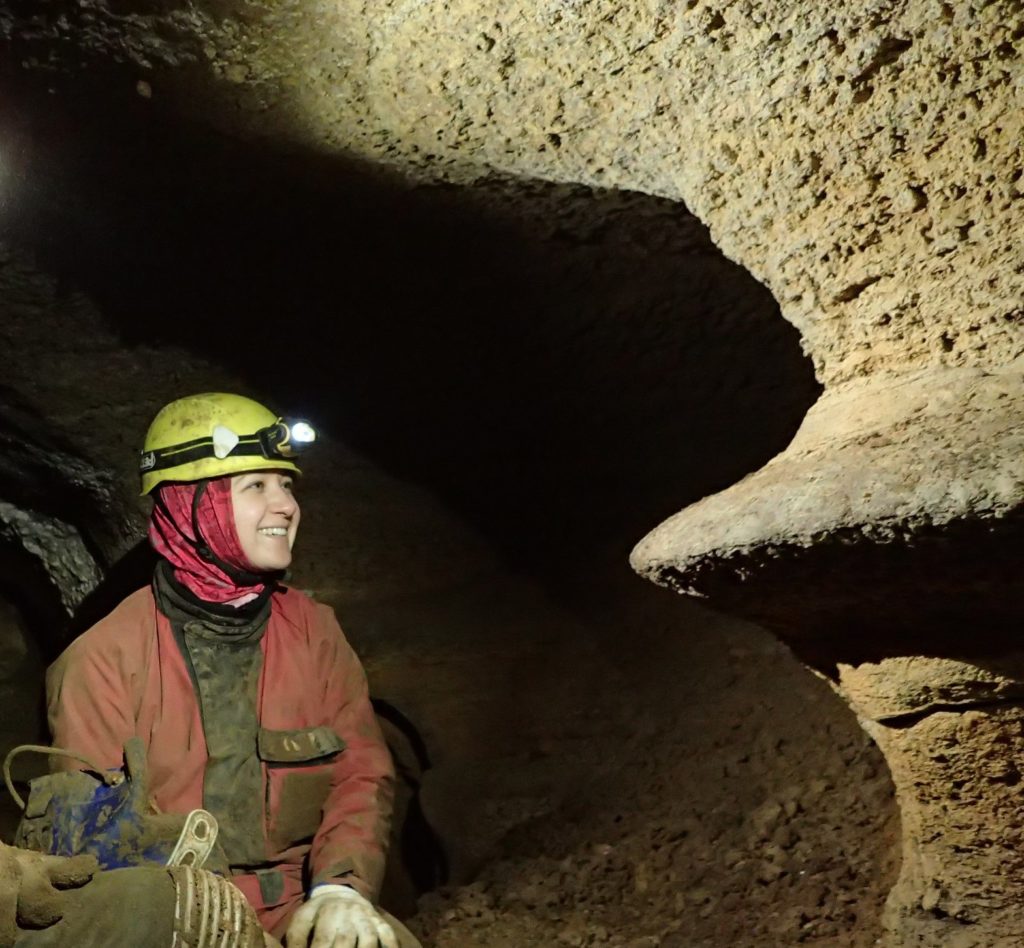
What makes you unique as a scientist? Most of us are confronted with this question sooner or later in our career, for example when applying for jobs or research grants. The answer is not always easy, especially for Early Career Researchers (ECRs) still developing a strong scientific profile. For me, being able to clearly identify my research niche has been a long process that involved developing independent thinking and the confidence to believe in the worth of my ideas.
I describe myself as a paleoclimatologist and (bio-)geochemist with an interest in understanding how Earth’s climate and the carbon cycle are interconnected over different timescales. In particular, I study how terrestrial ecosystems respond to climatic change, at present and in the past. My approach is unconventional, as I use karst caves and speleothems, the secondary carbonate precipitates that form in caves, as archives to study the terrestrial carbon cycle and its response to climatic perturbations.
My interest in the natural world sparked early on: I grew up amidst the most stunning landscapes in southern Switzerland, where geology and cultural past are visible at every step and strongly entangled with the present landscape. This environment stimulated my mind and my curiosity about natural processes and how humans influence them and it is not a surprise to me that I ended up becoming an Earth and climate scientist. While at first, I was mostly interested in what I knew best, mountains, their formation and societal relevance, I completely changed gears after being introduced to the underground world of caves during my masters.
My PhD project was a fortuitous collaboration between the University of Durham (UK) and ETH Zürich (Switzerland), and allowed me to work on a range of unconventional and novel proxies to trace carbon cycle processes in speleothems and cave systems. In particular, I applied and developed novel geochemical proxies for speleothems based on carbon isotopes, measured both in the inorganic carbonate matrix and in the tiny fraction of organic matter entrapped in speleothems. These proxies can inform us about past hydroclimatic conditions and surface ecosystem processes, but are still a niche application in speleothem research. After my PhD, I had the opportunity to dive deeper into questions related to the signature of terrestrial ecosystem processes preserved in speleothems by studying samples from the Siberian permafrost region during a postdoc at the University of Oxford. Unanswered questions from my PhD and the experience from my postdoc then gave me the tools and motivation to apply for a Swiss National Science Foundation (SNSF) Ambizione fellowship, which now allows me to follow an independent research agenda and be the PI of a small group at the University of Bern. My unconventional research direction also led to me being awarded the EGU 2021 Climate Division Outstanding Early Career Scientist Award, a great honour and validation for me.
This short description highlights what probably every modern scientist faces: our research does not fit neatly into one category. Many of us work in interdisciplinary settings and have interests that are broadly interconnected between different (sub-)fields of our disciplines. On the other hand, most of us, especially at the ECR stage, are extremely specialised in the methodologies we use, which sometimes makes it difficult to translate our research to a broader audience. I have found that the following points were very helpful to synthesize my research direction for a broader audience, defining my research niche, and setting clear goals for future research.
Think creatively about your academic expertise
As an introverted person with a desire to belong to a community, I have long struggled with the fact that my research does not neatly fit in a box. Applying biogeoscience questions to the speleothem archive, primarily viewed as an inorganic sediment, means that my research is often on the fringe of several conventional research fields. In the past, this has often made me feel alienated. On the practical side, I often found it difficult to find venues to present my research, for example which conferences or journals would cater to the audience I am trying to reach. Luckily, I had amazing mentors and supervisors during my PhD and after, who have encouraged me in my projects and showed me how to frame my unconventional research expertise as a strength.
Now I am able to position myself as an independent researcher with a unique profile. This is still a work in progress: my research interests are shifting over time, depending on my own progression as a scientist, who I am collaborating with, and external factors, such as funding situation and infrastructure available. I find that in some way I keep reinventing myself, which is part of the creative process that shapes a scientist and leads us to new questions and projects. For example, in my Ambizione project I am trying to understand the carbon cycle in the subsurface Critical Zone trough a long-term processes study in a Swiss cave system, which is a new topic for me. The exchange with the larger scientific community, via conferences, meetings, and working groups such as facilitated through PAGES (http://pastglobalchanges.org/), are great catalysers for new ideas and a source of inspiration.
Project proposals and job applications as tools for reflection
Writing proposals and applications for permanent academic positions has been one of the best ways to reflect on my scientific goals and determine strengths and unique selling points in my expertise. I was lucky to be able to write small project proposals directly after my PhD to receive funding through the SNSF mobility scheme. This funding allowed me to move and pursue an independent postdoc, but also taught me to view my unconventional path as something that sets me apart from many other candidates. Besides the obvious advantage that your own funding brings, writing a grant proposal helped me reflect on my plans and ambitions. Although it is a frustrating experience when not successful, the time spent was not wasted, as it helped me grow. Creating a web presence (website, social media) also played a significant role in understanding and shaping my scientific niche.
Overall, these early experiences set the stage for me to apply to larger pots of money and competitive academic positions.
Find a supportive community and uplifting mentors
I have been lucky to have some amazing mentors, who have been instrumental in connecting me to the right people, providing advice, and giving me feedback on my work and future plans. Moreover, belonging to a community, such as for example the PAGES working group SISAL has given me a feeling of belonging and countless opportunities for networking and collaborations.
Apart from the strategic considerations going into collaborations (who is best suited to help me achieve a certain research goal?) I find the human dimension increasingly important. Collaborating with colleagues I get along with on a personal level is so much more fun and ultimately productive than when we remain strictly professional.
Now, five years after completing my PhD, I can comfortably describe my research niche. I still worry about not being able to fulfil my research goals, particularly relating to high risk projects. However, I also see and exploit the uniqueness of my scientific profile that my unconventional approaches bring and I feel more confident and certain of what my near- to mid-term goals are.
My advice to others trying to define their research niche is to not be shy about what sets you apart from others: frame that as your main asset, even if it feels daunting at times. Use any opportunity to train yourself in selling your unique skills and vision. And don’t forget about the power a good network of honest colleagues and friends, who can give you feedback and help you (re)define your ideas and goals. As with many things, defining your research niche takes time and is an ongoing process that is key to the development of new ideas and ultimately leads to novel research. It should therefore not be an afterthought, but the core of our scientific work.
This blog was edited by the editorial board.


바카라사이트
The author’s experience encourages other researchers to explore different areas and not be afraid to shift focus. It’s a valuable reminder that finding the right niche often requires a willingness to experiment and adapt.